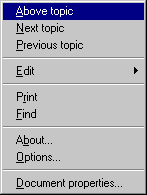|
A conventional book is typically divided into chapters and sections.
Many hypermedia documents
are divided into chapters and sections in the same way.
Each section of a large original document is broken up into smaller
documents for easier viewing in techexplorer.
As a result, each section is stored
in its own separate file and and is viewed in its own window. Document links
contained in each file might represent the logical structure of the document
as a collection of chapters and sections, and allow you to conveniently navigate
among the sections.
When you are viewing a long section, you can use the
scrollbar on the right (and sometimes on the bottom)
of the techexplorer window
to move around the section. You can also use the
PgUp, PgDn, and up and down arrow
keys to scroll the document window.
A hypertext link in a document is an active area
in a document that points to a specified location in a document.
If your mouse hovers over a hypertext link, information about
the link is displayed on the status bar at the bottom of the screen.
A hypertext link
may point to a different location in the same document or to a location
in a different document. A hypertext link usually appears in
blue and your mouse cursor always turns
into a hand when it passes over a link.
On the techexplorer document context menu

there are three entries labelled
Above topic,
Next topic, and
Previous topic.
These topic links can be used to move left to the topic preceding
the current topic, right to the topic following the current
topic, or up to the topic that logically contains the current
topic. In some documents, these links point to the previous
or next section, or to the table of contents for the current chapter.
In case there is no "above," "next," or "previous" topic, the corresponding menu
item will be grayed out and unavailable.
Note: The Active control version of techexplorer does
not support hypertext links when used with applications other than Internet
Explorer.
|







